| |
Chestnut Tree Perfection: The Selection of a Cultivar
The perfect chestnut tree for one chestnut producer may not be the perfect
chestnut tree for someone else. From the top we have to look at the
consumer's bias resulting in defining the market for chestnuts, the growers
expectations, the locality of the chestnut farm and things that can cause
problems with getting chestnuts to market. That is just 4 things we need to
consider when selecting a chestnut tree for commercial production. How is it
that these 4 simple things can result in a very difficult task? Let's examine
each of these as a whole instead of just a quarter of the entire problem.
We will start with the end first and work our way backwards. The end is when
the chestnuts we have produced have been processed and are ready to be
consumed. The beginning is defining the market we will be producing for. The
location of the orchard may have already been determined by where you live
with a few exceptions. Grower's expectations are almost always well above
what the average grower actually experiences.
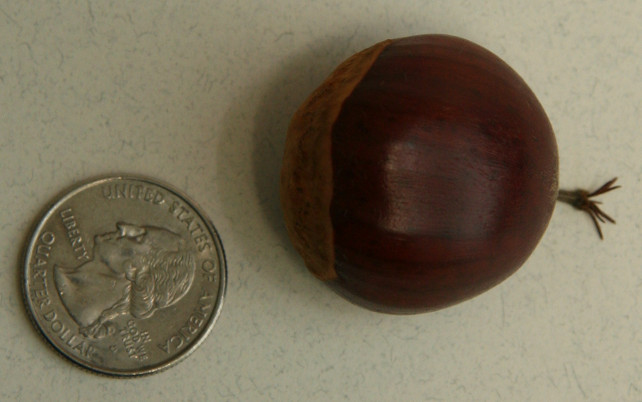
This perfect chestnut is almost 1 1/4 inch across
Grower's expectations can be things like producing X pounds per acre every
year; 100% of the nuts are at least X inches in size making them all larges
without cracks in the shell; all the chestnuts fall on the same day each year;
rains come and deliver the exact amount of rain to have a great harvest;
chestnut prices per pound are 1/100th of the price of an acre of land; no
bugs, or other bad things attack the chestnut trees; and prime chestnut tree
farm land sells for $500/acre. This is a perfect list ready for many
shortcomings. Now lets convert these expectations to requirements for a
chestnut tree. The price of an acre of farm land is an important piece
because the chestnut producer will need to receive enough revenue from that
acre to be compensated for the investment in the land. The availability of
water is also very important no matter if the water is pulled from a lake,
a river, or the sky, chestnut trees need about 24 – 40 inches of water
during the growing season. In the Pacific Northwest, about half the water
comes from water in the soil from the winter rains. The other half come from
rain during the growing season and irrigation. If water is a problem then
selecting a chestnut tree that can produce even when there is water stress
is important.
Yield is a term businesses use to describe the percentage of units good
enough to be sold. The yield does not include products made but could not
be sold. For chestnut producers yield is defined as pounds per acre of nuts
meeting the requirements of the minimum to be sold. The goal is produce
something very valuable from nothing. Chestnuts require inputs to achieve
maximum yields. These inputs are X square feet of land, water, fertilizer,
labor for orchard maintenance and harvesting, and any other resource needed
to produce chestnuts. For many growers the minimum yield is going to be 1200
lbs of nuts that can be sold to the acre. This is what will be required to
recover the input costs. The yield range of chestnuts is between 0 and 6000
lbs to the acre. For low intensity orchards with trees 12 or more years old
the average yield is about 1200 lbs to the acre for Chinese chestnut trees
and about 2000 lbs for European hybrid trees. Using high intensity practices
chestnut trees have produced as much as 6000 lbs to the acre. When choosing a
chestnut cultivar for commercial production, the yield is almost as important
as nut quality.
Nut quality has many key components with the top components being nut
sweetness, nut size, ease of peeling, nut shape, nut color, and the texture
of the kernel. Consumers are always requesting large sweet nuts, leaving some
of the other attributes out of the discussion. A great business is always
going to go beyond what the consumer asks for by delivering nuts delivering
good results in all the attributes. Without asking, consumers expect the
chestnuts will peel easily. This one attribute is a make or break deal
changer for the chestnut producer. Chestnuts have booth an outer shell and
a pellicle protecting the chestnut kernel. Ease of peeling a chestnut
includes removing both the shell and pellicle from the kernel, but mostly the
pellicle as it can adhere to the kernel (aka Pellicle adhesion to kernel).
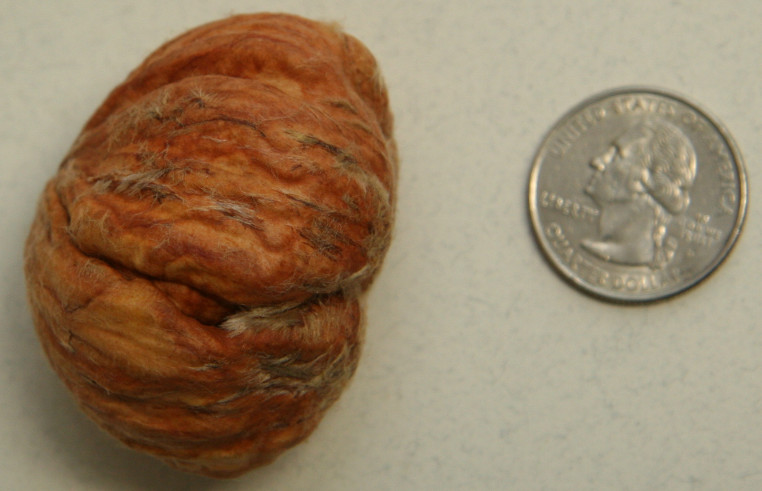
This is what a not so good chestnut kernel looks like inside the shell. It
has deep valleys causing pellicle intrusion.
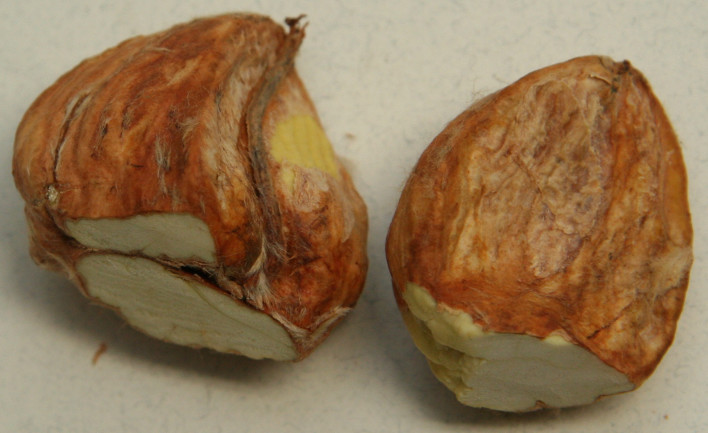
A chestnut with the multiple kernels separated
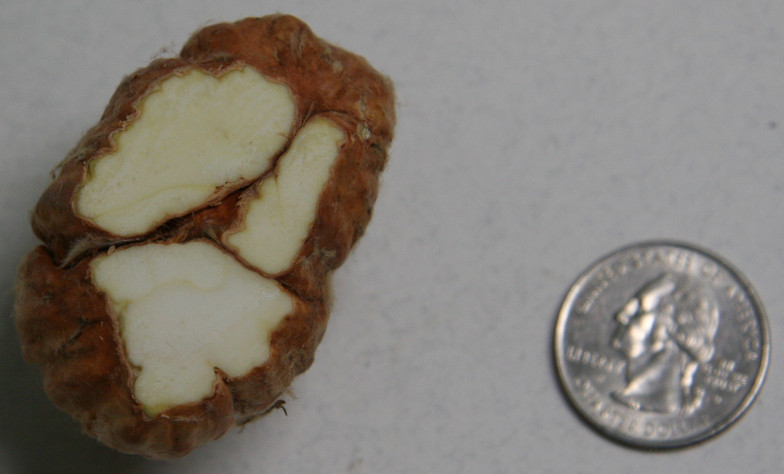
This is a dissected chestnut kernel showing pellicle intrusion into the kernel
Most growers will claim their chestnuts are very easy to peel. Before
settling in on a primary cultivar for your production, buy a few pounds of
the cultivar from another grower in the area and check to see how the nuts
taste and peel. In addition, check the size of each nut and calculate the
number of nuts per pound. Chestnuts destined for fresh market will need to
be 1 1/8 inches (a standard for a large) or larger (about 32 nuts per pound).
The cultivar you choose for your primary producer should be able to produce
90% large nuts without cracks in the shell.
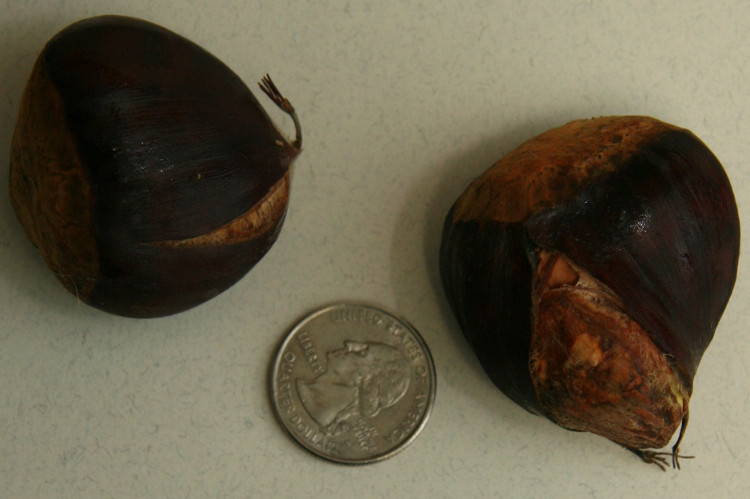
Unmarketable/trash chestnuts with splits
There is a softly spoken secret with chestnut production, “Chestnut trees
produce the same tons per acre, be it a lot of little chestnut, or fewer
large chestnuts”. Getting the chestnut trees to produce large chestnuts is
challenging and labor intensive. If you are going to produce a high quality
sell able product then you will have to work at it, it is not going to happen
magically with no effort. Chestnuts smaller than ¾ inch are trash and
unsellable except for use feeding animals. Chestnuts between ¾ inch and 1
inch can be sold as “Small” and people buy them but not enough to target as a
producers primary market. Any chestnut with a crack is trash no matter how
large it is. Cracked chestnuts usually go bad much faster than chestnuts
without cracks.
There are two more aspects of chestnut quality to look at. Some chestnut
cultivars have a tendency to produce multiple kernels in the nut. The kernels
are separated by the pellicle. There is another quality issue referred to as
pellicle intrusion. This is where the pellicle follows a valley into the
chestnut kernel. For some chestnuts for fresh eating where the nut is very,
very, very, easy to peel, this is not much of a problem. If the chestnuts are
going to be made into flour or other product this pellicle intrusion reduces
the quality of the product.
If there are no other growers in your area to glean information from, your
efforts will be what is called a pioneering effort. Since there is not
another source for chestnuts in your growing area to compare then you will
need to take a few trips to neighboring areas to find chestnut producers. The
farther you have to travel the higher the risk of selecting a cultivar that
may not work well for your farm. The best way to mitigate this risk is to
select several chestnut cultivars (grafted trees) to test on your farm. To
test a cultivar you will need at least 5 trees of each one being tested. If
takes at least 5 years for the grafted chestnut trees to get to a size that
will give results that is consistent and measurable. Because each growing
year has variances the testing period may need to be extended out to 8 to
10 years.
How much more difficult can this producing chestnuts be if the project has so
many unknowns? The most difficult issues have been dealt with except for the
problems of keeping the chestnut trees happy and healthy. This is where the
information becomes very scarce. Here is a list of the things the scientists
have figured out for us:
1. Wind or a thick layer of ice will break chestnut tree branches
2. A heavy load of chestnuts on a poorly formed tree will break branches
3. Water saturated soils during the growing season will damage or kill
chestnut trees
4. Chestnut trees like a soil pH of between 4.9 and 5.7
5. Chestnut trees need about 0.1 pound of nitrogen per inch of tree diameter
at the base
6. Clay soils are a poor choice for a commercial chestnut farm
7. Chestnut trees require a minimum spacing of 20 feet by 20 feet
8. Chestnut trees are not self pollinating
9. Lots of creatures like eating chestnut trees
10. Lots of creatures like eating chestnuts
11. A pound of high quality chestnuts sell for more than a pound of nice beef
steak at retail
12. Chestnut trees can live for more than 1000 years, build a business that
can live long too
This is the dozen of basic rules for getting started with becoming a
commercial chestnut producer. Adding to this list would only create road
blocks for people interested in becoming commercial chestnut producers and
would not likely hold true for all chestnut producers. Keeping chestnut trees
happy and healthy is not much different than keeping a garden happy and
healthy except it is on a much larger scale and time is measured in years
instead of days to harvest.
Now lets get back to the issue of the marketing the chestnuts. This is the
one area most growers overlook or hand to someone else to take care of for
them, a broker or co-op is often chosen. The questions of how to dispose of
the chestnuts is often asked with, “Where am I going to sell these
chestnuts?” If we are going to market our chestnuts the question is asked
with, “Who purchases these chestnuts?” Several Universities in the US have
performed market research looking at the market for fresh chestnuts over the
years. The results of this research gives us a good idea of who, as
consumers, buys fresh chestnuts. The answer is not simple but several general
observations can be presented.
1. People with higher than average incomes
2. People who, as a heritage from their ancestors, have consumed fresh
chestnuts
3. Chiefs delivering a dish that is differentiated from the competitors
offerings
4. People in their 40's and older
So this is who is purchasing the chestnuts, we still have to answer the
question of “How are these chestnut consumers purchasing their fresh
chestnuts?” If we look at the volumes of chestnuts sold in North America each
fall, we find most people are purchasing their chestnuts from a local grocery
or specialty store. These stores have two options for purchasing fresh
chestnuts with the most commonly selected option is a grocery distributor
such as United Natural Foods. The other option, requiring much more work on
the part of the produce buyer, is purchasing from a local producer. The local
producer has only one thing going for them when selling to a local store,
there is a giant way passing through North American call “Buy Local”. This
means that produce buyer has to keep the consumer happy by following this
trend so he or she can say “Yes, this is locally produced.” How lucky is the
local chestnut producer with the “Buy Local” movement. What does this have to
selecting a cultivar? In a way not much, but if we want the consumer to
purchase chestnuts many times over their life times then the chestnut producer
has to deliver a quality product even if the consumer has no idea what a good
chestnut is. To be successful, the chestnuts you sell into your market must
meet or exceed the consumer's expectations. The expectations were discussed
at the beginning of this article.
|
|





